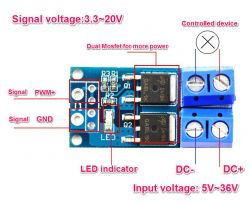Hello.
Has anyone perhaps encountered the case that when I feed a PWM signal to a module (or MOSFET), I always get the full voltage at the output regardless of the PWM fill given? The PWM signal is applied correctly - I checked with a multimeter. The voltage and frequencies agree. This happens regardless of the amplitude of 0 - 3.3V or 0 - 5V. To make it funnier, when I constructed my father an aquarium lamp controlled by PWM via current drivers it all worked correctly. I am attaching an overview diagram and would appreciate any hints. .
.
Has anyone perhaps encountered the case that when I feed a PWM signal to a module (or MOSFET), I always get the full voltage at the output regardless of the PWM fill given? The PWM signal is applied correctly - I checked with a multimeter. The voltage and frequencies agree. This happens regardless of the amplitude of 0 - 3.3V or 0 - 5V. To make it funnier, when I constructed my father an aquarium lamp controlled by PWM via current drivers it all worked correctly. I am attaching an overview diagram and would appreciate any hints.
 .
.







